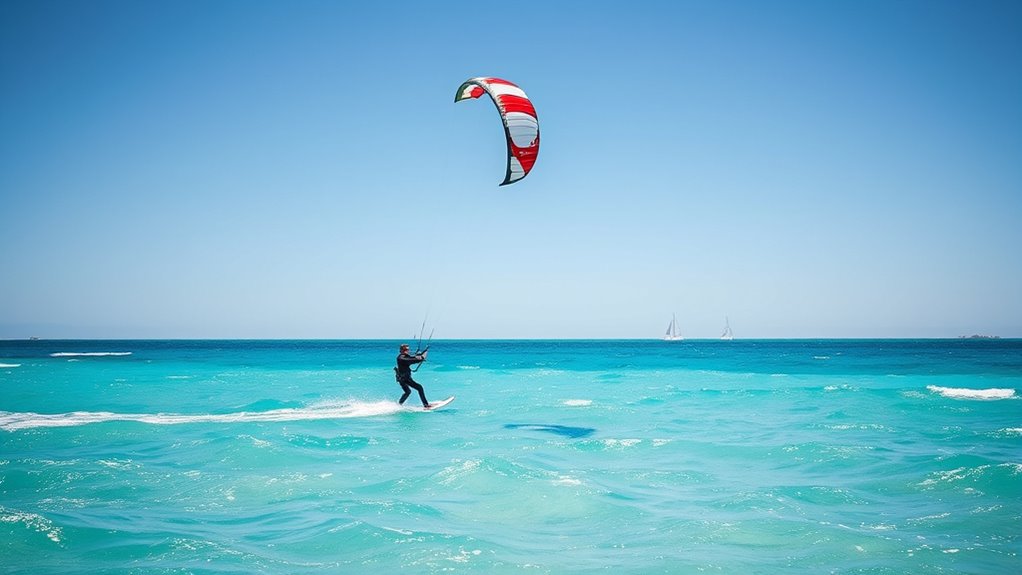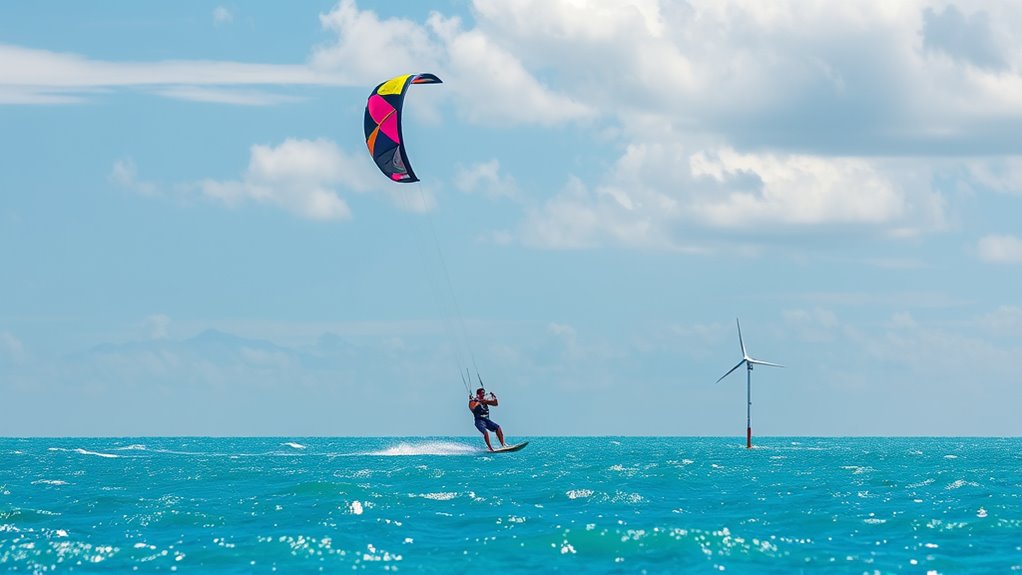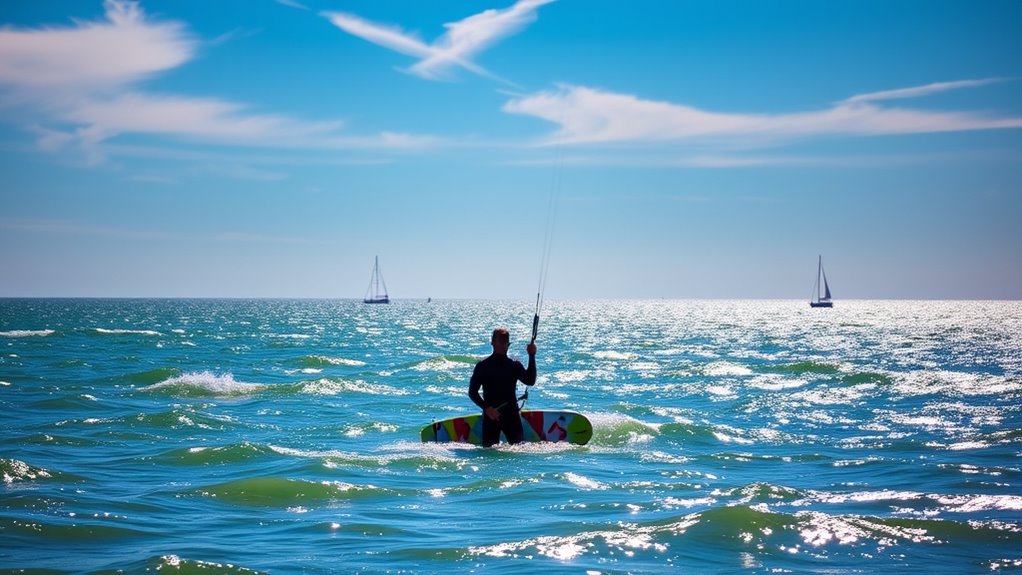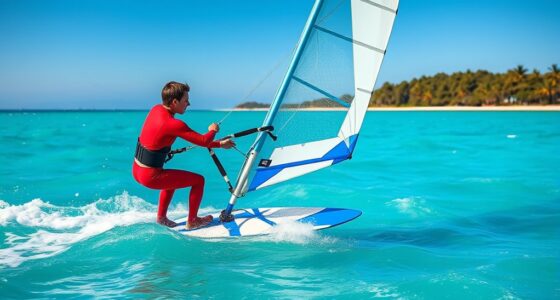To understand wind conditions for kitesurfing, you need to pay attention to wind speed, direction, consistency, and gusts. Ideal wind helps you stay safe and perform well, while too little or too much can cause problems. Use tools like anemometers and observe natural cues, such as water ripples and cloud movement. Planning your session around accurate forecasts and local patterns guarantees better safety and fun—keep exploring to master the details.
Key Takeaways
- Measure wind speed accurately using anemometers and observe water ripples and cloud movement for real-time conditions.
- Recognize wind direction—onshore winds are safer, while offshore winds can create hazardous conditions.
- Understand wind consistency versus gustiness to plan for reliable power and adjust techniques accordingly.
- Monitor thermal winds and wind shear patterns, which influence daily wind strength and quality.
- Check trusted weather forecasts and local topography to select optimal days for safe and enjoyable kitesurfing.
The Basics of Wind Speed and Its Impact on Kitesurfing

Understanding wind speed is essential because it directly affects your kitesurfing experience. The right wind speed ensures you have a safe and enjoyable session, while too little or too much wind can be dangerous. Light winds might not generate enough lift, making it hard to get on the water or stay planing. On the other hand, high wind speeds increase wind impact, which can lead to loss of control or difficulty handling your kite. Knowing how to gauge wind speed helps you choose the appropriate equipment and set your technique accordingly. Different conditions require different wind speeds for optimal performance. By understanding how wind impact varies with speed, you can better anticipate how your kite will respond, making your session safer and more fun. Understanding wind speed is a fundamental aspect of the Law of Attraction, as positive expectations and mindset can influence your perception and reaction to changing conditions, much like how Gold IRA Rollovers can provide stability amid market fluctuations. Additionally, being aware of seasonal variations helps you plan your trips around optimal wind conditions, ensuring a more successful and enjoyable kitesurfing experience. Recognizing wind consistency over time can help you identify the best periods for consistent performance.
Reading Wind Direction and Its Significance on the Water

Reading wind direction is essential because it determines how the wind flows across the water and affects your kitesurfing experience. Knowing the wind direction helps you anticipate water currents, which are influenced by the wind’s path. For instance, a offshore wind blows away from the shore, creating challenging conditions, while an onshore wind blows toward the land, offering safer, more controlled sessions. Pay attention to how the wind hits the water’s surface and the way water currents move in response. Understanding wind patterns is crucial for optimizing safety and performance on the water. Recognizing local weather forecasts can further enhance your planning and safety during kitesurfing sessions. Being aware of the benefits of glycolic acid exfoliating toner can also help you prepare your skin for outdoor activities by maintaining proper skin health, especially in sun-exposed environments.
The Role of Wind Consistency and Gusts in Your Session

Wind consistency and gusts can make or break your kitesurfing session, as steady winds provide reliable power, while gusts introduce unpredictability. High gust variability can challenge your control and safety, making it harder to plan your moves. On the other hand, consistent wind offers better wind stability, helping you focus on technique without surprises. To navigate these conditions, consider:
Steady winds enhance safety and control, while gusts require vigilance and quick adjustments for optimal kitesurfing.
- Monitoring gust patterns to anticipate sudden changes
- Adjusting your kite trim for better handling during gusts
- Choosing spots with predictable wind behavior
- Being prepared to adapt your session based on gust intensity
- Using vetted equipment and apparel designed for variable wind conditions to improve safety and performance. Additionally, understanding the air quality in your area can help you plan sessions around weather conditions that may affect wind patterns and overall comfort. Incorporating data-driven strategies from weather forecasts can further enhance your ability to anticipate wind behavior and optimize your kitesurfing experience. Recognizing wind shear effects can also assist in predicting sudden shifts in wind speed and direction, improving your safety measures. Maintaining awareness of local weather patterns can provide valuable insights into typical wind behavior, aiding in better planning for each session.
Tools and Techniques for Monitoring Wind Conditions

To effectively monitor wind conditions, you need a combination of reliable tools and keen observation techniques. An anemometer is essential for measuring wind speed accurately; verify proper anemometer calibration for precise readings. Regular calibration helps you trust your data, especially when conditions change. In addition to instruments, develop skills like wind shadow analysis—observe how natural features, buildings, or trees affect wind flow and create shadows or gusts. Use visual cues, such as ripples on the water or cloud movement, to complement your measurements. Combining these tools and techniques allows you to gauge wind strength reliably and identify subtle shifts, helping you make more informed decisions before hitting the water. This approach improves safety and maximizes your kitesurfing experience.
Planning Your Kitesurfing Days Based on Wind Forecasts

Planning your kitesurfing sessions around accurate wind forecasts guarantees you hit the water when conditions are ideal. To do this effectively, consider these key factors: 1. Check wind shear patterns**—sharp changes in wind speed or direction can affect control and safety. 2. Monitor thermal winds—these naturally develop during the day, providing consistent conditions if forecasted accurately. 3. Forecast reliability—use trusted sources for short-term and long-term predictions to avoid surprises. 4. Wind consistency**—look for steady winds rather than gusty or variable conditions, ensuring a smoother session. Additionally, understanding wind conditions such as temperature and humidity can help you better anticipate changes in wind behavior, especially since these elements influence thermal wind development. Recognizing local topography can also significantly impact wind patterns, enabling more precise planning for your kitesurfing days. Being aware of potential weather changes further enhances your ability to adapt and enjoy safe, optimal sessions. Considering the Gold IRA market trends and how they might affect investment decisions can also be valuable if you’re integrating financial planning with your water sports activities.
Frequently Asked Questions
How Do Local Terrain Features Influence Wind Behavior for Kitesurfing?
Terrain impact and obstacle effects considerably influence wind behavior for kitesurfing. When you encounter hills, trees, or buildings, they can alter wind speed and direction, creating gusts or lulls. These terrain features channel or block airflow, making wind patterns unpredictable. As you plan your session, consider how local terrain impact might affect wind strength and consistency, ensuring you choose safe and ideal spots for kitesurfing.
What Are the Signs of Changing Wind Conditions While on the Water?
You notice changing wind conditions when wind speed fluctuates noticeably or wind direction shifts unexpectedly. Feel the pull on your kite weaken or strengthen, indicating a speed change. Watch for clouds moving swiftly or altering shape, signaling wind shifts. Listen for sound changes, like gusts or lulls. These signs help you anticipate wind speed and direction changes, keeping you safe and prepared while kitesurfing.
How Can I Differentiate Between Safe and Unsafe Wind Gusts?
You can tell if wind gusts are safe or unsafe by paying attention to gust strength and wind direction. Safe gusts feel steady and predictable, with only slight increases in strength, while unsafe gusts suddenly spike or change direction sharply, making control difficult. Keep monitoring the wind’s behavior, and if you notice inconsistent gusts or a sudden shift in direction, it’s best to stay cautious or head back to shore.
Are There Specific Wind Conditions Suited for Beginners Versus Advanced Kitesurfers?
You should look for beginner-friendly conditions, like steady winds between 12-20 mph, when starting out. These create safer, more manageable rides. Advanced wind challenges, such as gusty or stronger winds over 25 mph, are better suited for experienced kitesurfers who can handle the increased power and unpredictability. Always assess the wind consistency and your skill level to choose the right conditions and enjoy a safe, fun session.
How Do Seasonal Wind Patterns Affect Kitesurfing Planning?
Like the tides that shape our coastlines, seasonal wind patterns influence your kitesurfing plans. You need to track seasonal wind variations and align your trips with annual wind cycles to catch the best conditions. By understanding these patterns, you guarantee safer, more enjoyable sessions. Planning ahead around these cycles helps you avoid lulls or storms, making every ride smoother and more thrilling, no matter the season.
Conclusion
Understanding wind conditions helps you kite safely and enjoy your session. Don’t worry if forecasts aren’t perfect—learning to read the wind and using reliable tools will boost your confidence on the water. Even if the wind varies, small adjustments can keep your ride smooth and fun. With practice, you’ll master wind awareness, making every kitesurfing day exciting and safe. Just stay prepared, and the wind will become your best ally.










